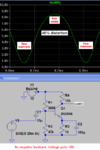Darktrax
Full Member level 5
I know what the fundamental is, call it Fo
When I say "third harmonic distortion", I am thinking there is more of the signal at 3*Fo than I would like.
Is not the "second harmonic" the one on the spectrum analyzer at frequency 2*Fo?
For me, there is no "first harmonic". Have I been wrong about this?
The term is used in RF, audio, music, physics, philosophy, etc. and the definitions vary. For some, me included, the first harmonic is also the fundamental. For others, it is the first one encountered after the fundamental.
Here is a definition I think is wrong-->https://stereos.about.com/od/glossaryoftermsh/g/harmonic.htm
So - is there a norm here?
When I say "third harmonic distortion", I am thinking there is more of the signal at 3*Fo than I would like.
Is not the "second harmonic" the one on the spectrum analyzer at frequency 2*Fo?
For me, there is no "first harmonic". Have I been wrong about this?
The term is used in RF, audio, music, physics, philosophy, etc. and the definitions vary. For some, me included, the first harmonic is also the fundamental. For others, it is the first one encountered after the fundamental.
Here is a definition I think is wrong-->https://stereos.about.com/od/glossaryoftermsh/g/harmonic.htm
So - is there a norm here?
